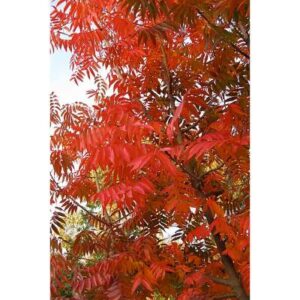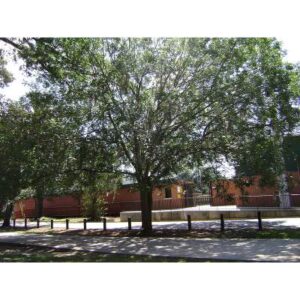The Major difference in both trees is Chinese pistachio tree has red berries that birds like, but not the red push pistache tree. When these berries are ripe in the fall, they are red. In the winter, they turn blue or purple. Furthermore, Chinese pistachio trees provide excellent shade, and in the fall, their leaves turn bright red, orange, and yellow.
Hey there, fellow college students! If you’re on the hunt for the perfect tree to spruce up your place, you’ve come to the right place. We’re about to break down the Red Push Pistache and the Chinese Pistache, two cool trees that can totally upgrade your garden game. They’re not just any old trees; they’re like your garden’s BFFs.
So, let’s get down to it and find out what makes these trees tick.
Comparing Red Push Pistache and Chinese Pistache
Let’s take a quick look at what makes these trees unique.
Classification and Origin
These trees are cousins in the tree family. Imagine them as siblings with the same last name but different first names.
Red Push Pistache – The Cool Hybrid Chinese Pistache – The Ancient One
Now, let’s go on a little world tour. The Red Push Pistache, like the new kid in town, is originally from the United States. It’s like a tree mixtape, created by combining P. atlantica and P. integerrima, giving it a unique blend of characteristics.
On the flip side, the Chinese Pistache is like the wise old sage. It hails from China, specifically the central and western parts. This tree has been around the block for centuries, gracing Chinese and Taiwanese landscapes. It’s like a tree with a ton of stories to tell.
Also Read :
Chinese Pistache Tree: Male vs. Female – Know The Difference
Description
Chinese pistachio trees are different from red push pistachio trees in a number of ways that make them a unique and beautiful choice for gardening. The way they grow their berries is one big difference. Different kinds of birds love the red nuts that Chinese pistachio trees harvest. The color of these berries changes in an interesting way. When they’re fully ripe in the fall, they turn a rich red color, but in the winter, they turn a striking blue or purple color. This change with the seasons makes the tree more interesting to look at.
Also, Chinese pistache trees provide great shade, making them a great choice for people who want to escape the heat of the sun. It’s possible for this shade to make outdoor areas much more comfortable and useful, making them better places to relax or have a party.
The leaves of Chinese pistache trees are another interesting thing about them. In the fall, their leaves change into beautiful shades of red, orange, and yellow. This stunning show of fall colors can make any scene look amazing, and it stands out against the green of the red push pistache.
Red Push Pistache
Picture a tree that stands tall at 25 feet and spreads its branches to 20 feet. The Red Push Pistache is like the chill medium-sized tree at the party, with a cool umbrella-like crown providing awesome shade. In the fall, its leaves are on fire, all fiery red, and then they mellow out to a calming dark green in the spring. But here’s the deal breaker: this tree doesn’t bear fruit. So, if you were hoping for a pistachio farm, this ain’t it.
Chinese Pistache
Now, imagine a tree with similar dimensions, around 25-30 feet tall and a 25-foot spread. What sets it apart is its incredible fashion sense. In the fall, its leaves turn into a stunning blend of red, yellow, and orange, making your garden look like a sunset. But the party doesn’t end there; this tree also produces red berries that turn shades of blue or purple in the winter. It’s like a tree that loves changing its outfit.

Benefits and Uses
Okay, so these trees aren’t just eye candy. They’re like the Swiss Army knives of trees.
Both the Red Push Pistache and the Chinese Pistache are great for making your place look awesome. They’re like the cool art pieces that elevate your garden’s style. Plus, they provide shade, which is like nature’s air conditioner.
But here’s where the Chinese Pistache goes superhero mode. It can handle tough situations like a pro. Drought? No biggie. Strong winds? Piece of cake. Even salty coastal air? Bring it on. And it’s not bothered by pesky pests either. It’s like the superhero of garden trees, facing challenges head-on.
Growing Tips: How to Keep Your Tree Happy
Growing these trees is like taking care of a pet rock. It’s easy, but you still need to know the basics.
Red Push Pistache Growing Tips
- Sunlight: Give it lots of sunshine; it loves to bask in it.
- Water: Keep the soil moist but not soaking wet. Water it when it’s thirsty.
- Soil: Plant it in well-draining soil, like a cozy bed for a tree.
- Food: When it’s young, feed it some all-purpose fertilizer in the spring to help it grow big and strong.
Chinese Pistache Growing Tips
- Sunshine: This tree is a sun worshipper, so make sure it gets full sun all day long.
- Soil: Plant it in soil that drains well, like a sieve for water.
- Water: Once it’s grown up, it doesn’t need much babysitting. Water it once in a while, like checking in on your virtual pet.

Drawbacks and Things to Think About
Even the coolest trees have their quirks. Here’s what to keep in mind.
Red Push Pistache: While it’s super cool, it doesn’t give you any pistachios to snack on. Sorry, no nutty treats here.
Chinese Pistache: It’s a bit of a slow starter in life, so be patient. Also, those red berries it rocks? They’re not for us humans, but the birds are big fans.
Real-Life Examples
Let’s check out some stories of how these trees transformed regular yards into epic ones.
Story 1: John’s Chill Zone John, just your regular homeowner, planted a Red Push Pistache in his backyard. Over the years, it grew into a shady paradise, with fiery red leaves every fall. His garden became his chill-out spot, an oasis in the middle of the city’s chaos.
Story 2: Sarah’s Colorful Wonderland Sarah, a gardening enthusiast, chose the Chinese Pistache for her front yard. Its amazing fall colors turned her home into a burst of warmth during chilly months. As the tree got older, it started wearing a coat of red berries, making her garden look like a winter wonderland. It wasn’t just a tree; it was a living masterpiece.
Takeaways
- Both the Red Push Pistache and the Chinese Pistache are part of the Pistacia family, but they have their unique vibes.
- The Red Push Pistache is like the chill, fiery tree, while the Chinese Pistache is the fashion-forward one.
- They make your place look awesome and offer some serious shade.
- Plant them right, give them sun, and they’ll grow happily with minimal fuss.
- Remember their quirks, like the Red Push Pistache not giving you any pistachios and the Chinese Pistache’s slow start.
Frequently Asked Questions (FAQ)
Got some burning questions about Red Push Pistache and Chinese Pistache? We’ve got you covered! Check out these common queries below.
1. What’s the main difference between Red Push Pistache and Chinese Pistache?
The big difference is how they look and if they make fruit. Red Push Pistache has red leaves in the fall but doesn’t make any fruit. Chinese Pistache has colorful leaves in the fall and makes red berries in the winter.
2. Are these trees easy to grow if you’re just starting out?
Yes, they’re pretty easy to take care of, even if you’re new to gardening. Just make sure they get enough sunlight and have good soil.
3. Can I eat the berries from Chinese Pistache?
Nope, those berries are for the birds, not for us humans. They might look tasty, but they’re not.
4. Do I have to trim these trees a lot?
Not really. You only need to trim them a little to get rid of dead or crisscrossing branches. They’re naturally good-looking.
5. Can I grow them in pots or containers?
While you can start them in pots when they’re small, they’ll probably outgrow the pots pretty fast. They’re better for open spaces or gardens.
6. Do bugs bother these trees?
Not really. These trees aren’t too bothered by bugs, which is good news, especially if you live in a place with lots of pests.
7. When’s the best time to plant these trees?
Spring or late fall is the best time. That way, they can grow strong roots before the super hot or cold weather hits.
8. Do these trees need special care in the winter?
Once they’re big enough, they’re tough and can handle cold weather. Just make sure the soil doesn’t get too soggy.
9. Can I plant them close to buildings or structures?
It’s better to give them some space from buildings so they can grow without causing problems.
10. Do these trees give good shade in the summer?
Absolutely! These trees have big leafy canopies that give great shade when it’s scorching outside. They’re like natural umbrellas.
In Conclusion
In your garden adventure, these trees are like two different playlists. The Red Push Pistache is like the mellow tunes, and the Chinese Pistache is the upbeat jam. Whether you go for the chill vibes or the vibrant energy, both trees are ready to make your garden a masterpiece. So, happy gardening, friends!
